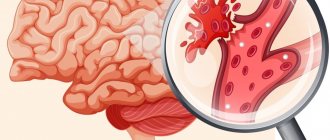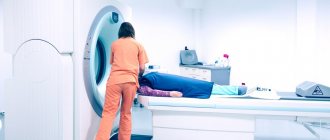Symptoms
In most cases, the disease manifests itself through hallucinations, frequent and long-lasting, observed for several years (the patient hears voices that no one else hears; he responds to these voices, giving the impression that he is talking to himself), speech becomes confused and unrelated thought, the subject or topic of conversation changes sharply, concentration of attention decreases. Unreasonable fears, obsessions, including those of a suicidal nature, paranoia and delusions often appear. There is a high probability of developing a depressive state and apathy (the patient may not say or move anything for a long time or acquire unnatural, mannered facial expressions, gestures and gait), loss of vital stimulus, lack of desires and needs. But with an increased stress level, the patient enters a state of strong emotional arousal. Schizophrenia is also characterized by pathological states of anxiety and obsessive-compulsive disorders.
Among the concomitant somatic diseases in schizophrenia, diabetes and osteoporosis, decreased levels of sex hormones and metabolic disorders in the blood and, as a consequence, atherosclerosis and pancreatitis are common; respiratory tract diseases and infectious diseases, heart disease. Increased risk of alcohol and drug addiction. The listed factors accompanying the disease lead to complete social disadaptation and a low level of human life expectancy.
.
Long-term studies reveal the following statistics of the disease: on average 5 people per thousand. In general, there is no gender predisposition, but men tend to have the onset of the disease at an earlier age than women.
Only advances in neurobiology have made it possible to study the causes of schizophrenia and the mechanics of the development of the disease in general. Genetic predisposition, neurobiological disorders, living conditions (both in childhood and in adulthood), urban factors (living in urban environments, migration and discrimination), interaction of biological (as the basis of the dopamine hypothesis), psychological and social parameters, exposure to adverse events , so-called stressors (life losses, loss of loved ones, sexual or other violence, difficult relationships in the family and in society) and their influence - the combination of these criteria and each of them separately are considered and studied as potential causes of the development of schizophrenia.
With early diagnosis, such nonspecific traits are observed as irritation over unimportant reasons, a desire for isolation from society, reluctance to form close and/or friendly relationships, lack of attachments and preferences, and detachment.
To diagnose schizophrenia, it is necessary to take into account the fact that the symptoms (their totality, and not a separate sign) must be observed for at least six months.
To make a diagnosis according to the ICD-10 criteria used in the Russian Federation, observation of at least:
- one of the possible symptoms: confidence in the accessibility of one’s own thoughts to others; delusional sensation of the body, limbs, thoughts, actions; voice hallucinations, including listening to body parts; crazy ideas fixed.
- two of the following symptoms: persistent hallucinations, both visual and auditory, together with delusions, lasting at least a month; sudden blocking of the thought process, a “spell” of thought, leading to abrupt speech; complete refusal to speak; actions and actions that contradict all accepted behavioral standards; movement disorders (excited gesticulation, “freezing”, unnatural plasticity of the body); lack of any external interests, fixation on one’s own experiences.
Diagnosis according to the DSM criteria adopted in the USA and some other English-speaking countries is characterized by the presence of the same spectrum of symptoms as for the ICD: delirium (paranoid and fantastic), hallucinations, obsessions, uncoordinated speech and others. Also: self-isolation, antisocial behavior, lack of social contacts. Emotionally, this manifests itself in avoidance of visual contact and lack of expression of emotions. In the behavioral sphere, there is a deterioration in self-care skills. The duration of all the above symptoms must be at least six months, and during this time period, symptoms such as delusions, obsessions, hallucinations, psychopathological speech disorders, behavioral and emotional disorders must appear within a month.
Features of behavior
Patients with OCD exhibit unusual behavior patterns. They are not specific and it is impossible to make a diagnosis based on them, however, experts note that obsessive-compulsive disorder is typical for people with the following traits:
- Responsibility for completing tasks. They strictly follow the rules and regulations, and often invent them for themselves, and then can no longer refuse them.
- Demandingness. This especially applies to managers. They not only follow the rules themselves, but also demand strict adherence to them on the part of their subordinates. The problem is that many people simply consider such orders meaningless and are not ready to tolerate such an attitude towards themselves.
- Superstition. People with OCD are very superstitious and believe in all sorts of omens. Usually the rituals they come up with are associated with superstitions.
Often a person gets bored with rituals, as a result of which he tries to get rid of them. However, anxiety prevents him from doing this. Some people believe that over time everything will go away on its own. However, in most cases the condition worsens and the symptoms of the disorder expand. As a result, it can develop into long-term neurosis.
One of the hallmarks of OCD is treatment resistance.
As you can see, some symptoms, such as voices, visions and intrusive thoughts, resemble signs of schizophrenia, especially pseudoneurotic.
However, they have much more differences. An experienced specialist will never confuse these two disorders. Let's take a closer look at schizoneurosis, or neurosis-like schizophrenia.
Treatment of schizophrenia
Just as the symptom spectrum is wide, so are the treatment methods for schizophrenia. Traditionally, helping a patient involves a combination of medication and psychotherapy
. Drug treatment consists of the drugs themselves and therapy with additives. Among the medications that do not cure schizophrenia, but significantly improve the quality of life, there are those whose action is aimed at correcting dysfunctions of proteins in DNA organization, since one of the biological factors of predisposition to the disease is associated with dysfunctions of proteins.
In symptomatic therapy, the use of neuroleptics (antipsychotics) is aimed at improving the patient’s social adaptation and social integration: by acting on the symptoms of psychosis, they are able to stop its progression. To reduce the risk of relapse, highly effective antipsychotic drugs such as clozapine and others (amisulpride, olanzapine, risperidone) are used. At the moment, the effectiveness and much higher percentage of safety of combination drug therapy have been proven: a combination of antipsychotics with drugs of a different nature (benzodiazepine, normotic anticonvulsants)
.
In each individual case, different methods of therapy are used. Yes, electroconvulsive
therapy is especially effective in cases of severe catatonia.
And insulin comatose
therapy, which ceased to be used in the West in the 50s of the last century, continues to be used in the Russian Federation due to the recognition of its uniqueness by some specialists.
In case of acute manifestations of the disease, observation in a hospital may be required. The decision on inpatient or outpatient treatment is made by a specialist, and forced placement in a hospital in the Russian Federation is regulated by law. Recently, the length of hospital stay has been significantly reduced, other methods of monitoring the development of the disease are being developed: psychological therapy, social therapy, neuropsychological rehabilitation, family therapy, creative types of therapy (art therapy, music therapy)
.
Alternative therapies (for example, Soteria houses or an antipsychiatric approach to the treatment of schizophrenia
) aim primarily at destigmatizing the disease.
For schizophrenia, it is advisable to use psychotherapy, which affects the social spheres of the patient’s life, and also promotes rehabilitation and active adaptation.
The symptoms of schizophrenia are so diverse that almost all spheres of life are involved in it: mental, emotional, physiological and social. Previously, it was believed that this disease was constantly progressing and the prognosis could only speak of partial remission. However, recent research in neurology, neurosurgery and psychiatry disputes this fact. In some cases, we can talk about recovery - complete or almost complete, for a long time and sometimes even without maintenance drug therapy. But the most correct goal of treatment is to restore functioning and alleviate symptoms, which subsequently leads to successful social integration and improved quality of life for both the patient and his environment.
General features of schizoneurosis
Pseudoneurotic schizophrenia is partially similar to sluggish schizophrenia, but in general it is dominated by neurotic symptoms. As for the symptoms typical for most forms of schizophrenic disorder, that is, delusions and hallucinations, they are, as a rule, absent in schizoneurosis. If the patient is not treated, then subsequently the signs become more and more numerous, and ultimately psychopathology is diagnosed.
The specific causes of pseudoneurotic schizophrenia are almost impossible to identify. However, there are known risk factors, including:
- heredity;
- genetic mutations;
- neurotransmitter dysfunction;
- psychomotor disorders;
- uncomfortable social conditions;
- psychological trauma.
The onset of the disorder usually occurs at a young age. As a rule, it is detected in teenage boys. However, the risk of getting sick remains in adulthood, both in men and women.
How can we help?
| If you have discovered some of the described symptoms, this may indicate the development of a mental disorder. In this case, it is worth contacting a psychiatrist for diagnosis and initiation of timely treatment. In addition to face-to-face appointments , we offer a remote consultation service (online) , which is not inferior in quality to a personal meeting. Thus, you can receive qualified assistance from a high-level specialist, no matter where you are. |
Our clinic, near the Eastern Administrative District of Moscow, in Reutov, employs specialists who have extensive experience in treating mental disorders. We use the most modern and advanced techniques, guided by the principles of evidence-based medicine. Effective assistance and confidentiality of information constituting medical confidentiality are guaranteed.
Differences
OCD differs from schizophrenia in many ways. A doctor will never confuse these two disorders. A common symptom is obsessions and compulsions. However, with neurosis, a person tries to overcome them or at least hide them. A schizophrenic does not do this, because he believes that everything is fine with him.
Neurotics retain common sense. They are aware of their actions, even if they are performed automatically, that is, in the form of compulsions. But at the same time they understand that such a state is not normal. Moreover, they try to behave correctly. Only in severe cases does control disappear completely.
In schizophrenics, mental functions are split. They are not critical of their condition. They may behave provocatively or strangely, but they do not understand that they are causing shock to others. In other words, people with this form of schizophrenia perceive themselves as healthy.
Hallucinations also occur during neurosis, but they are short-term and appear mainly before sleep, when the brain is tired, and after waking up, when brain activity is not as active as during the day. The OCD patient understands that the cause of the hallucinations is his illness.
In schizophrenia, voices and visions are spontaneous, but they can also be chronic. Delusions and hallucinations can transfer a person’s consciousness to another reality.
The main difference between OCD and schizophrenia is that the former does not cause personality damage. A person can completely get rid of the disorder without leaving a trace on his consciousness. Schizophrenia leaves a defect; it affects the person’s “I”. In severe cases, a complete collapse of the personality occurs.
Diagnostics
According to statistics, the disease manifests itself most often in adolescence. If there are certain triggers, you can feel the disease at a fairly young age. The onset of schizophrenia is usually observed before the age of 30–35 years.
Prussian psychosis
As noted above, the first symptoms of the disease appear at a young age; schizophrenic disorder does not appear in the second half of life. Acute psychosis in elderly patients is classified in psychiatry as “cyanotic psychosis” rather than schizophrenia. However, its symptoms are quite similar to those of schizophrenia. Hallucinations and delusions may occur. But, most likely, they will be of a vascular nature: vascular dementia, brain destruction (Alzheimer’s, Parkinson’s or Pick’s disease). In any case, such organic brain lesions are not related to schizophrenia. Quite often, the differential diagnosis of schizophrenia causes significant difficulties. This is especially true for the initial stage of the disease or periods of deep remission, as well as when one person combines alcoholism and schizophrenia or has suffered psychotrauma against which pathology has developed. Thus, within the framework of the differential method, it is quite difficult to determine the disease on your own. As noted above, not every symptom characterizes this particular disorder. But a person cannot suspect schizophrenia in himself, since this is associated with a loss of criticism.
He may, for example, discover depression or neurosis and, in connection with them, go to a specialist, who, in turn, should conduct a more detailed study and prescribe medication. But, unfortunately, the disease is often noticed by the patient’s relatives at fairly late stages and they are hospitalized in an acute condition, because advanced symptoms are most often interpreted as coincidences or coincidences, or as a consequence of stress or neurosis. Thus, everyone expects that they will go away on their own, and if they take medications, they are more likely of homeopathic or herbal origin, which do not cure the disease, but simply help to prolong it. Thus, due to incorrect diagnosis and late diagnosis, schizophrenic psychosis most often debuts in the patient in an acute form.
Differential diagnosis of the disorder
An important stage of diagnosis is the differentiation of a schizophrenic attack from a neurotic or other mental disorder, as well as the rejection of diseases of an infectious nature that have a destructive effect on neural connections.
For example, an acute psychosis or manic episode, also identified as a polymorphonic psychotic disorder, can also unfold against the background of other diseases, for example, within the framework of schizoaffective or bipolar disorder, which can serve as precursors, but in general are not related to schizophrenia, since they are to another cluster of diseases, a cluster of mood disorders. Bipolar affective disorder, for example, has a more favorable prognosis for life and work. However, even an experienced specialist can sometimes confuse the state of acute psychosis in a neurotic or other disorder with a schizophrenic coat (schizophrenic psychosis). That is why it is very important to observe a person with a team of specialists and in dynamics. The patient’s condition after recovery from acute psychosis is of great importance, since only the stagnation phase makes it possible to more clearly differentiate schizophrenia from other mental disorders.
Loss of self
Depersonalization is a state in which a person ceases to feel like a separate person who has his own thinking and his own will. Often such disorders occur in patients with indolent schizophrenia, especially if the disease lasts a long time and the patient does not receive any treatment.
A person ceases to feel his thoughts, emotions and aspirations as his own - it seems to him that his psyche is controlled by someone from the outside. At the same time, he calls everything that the patient does “automatic,” emphasizing the deficit of his own personality.









![Rice. 2. The role of vitamin B12 in the synthesis of the myelin sheath of nerve fibers [45] 2. The role of vitamin B12 in the synthesis of myelin sheath [45]](https://lovetherapy.ru/wp-content/uploads/ris-2-rol-vitamina-v12-v-sinteze-mielinovoj-obolochki-nervnyh-330x140.jpg)

